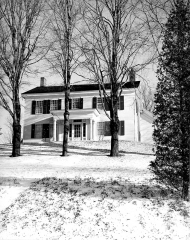Meanwhile, the Executive Committee had been receiving several applications for assistance from young men desiring ministerial training. By May, 1820, fourteen had been accepted as beneficiaries of the Society, that is, all or part of their expenses were paid out of its treasury. Since the Society did not yet have its own institution, they studied with Hascall, Kendrick, Clark, and the Rev. Elon Galusha in Whitesboro.
With the selection of Hamilton as the site for the school, it became necessary to obtain a full-time instructor. The Executive Committee sought in vain to engage at least three of the most promising young men in the denomination, one of whom, Stephen W. Taylor, some years later, became an outstanding teacher and president of their institution as well as the first executive officer of Lewisburg (Bucknell) University. The Committee finally fell back on Daniel Hascall “whose services thus far have been acceptable.” With ten young men, he began formal instruction on May 1st, 1820. Meeting in the third story over the Hamilton Academy, erected by the citizens of the village as per their agreement, Hascall, his students, and classroom represented the embodiment of the ideal cherished by the founders of the Education Society since 1817.
Colgate University had now come into being, though in a form vastly different from that of 1969. The first stage in its development was over. Daniel Hascall, Nathaniel Kendrick and their associates on the Executive Committee could report that though they were conscious “of a want of wisdom, to manage with any correctness, the unadjusted and complicated concerns of this infant Institution” they had “been much encouraged in the belief, that God has hitherto made it the care of his fostering providence.”*
* Baptist Education Society, Annual Report, 1820, 3, 7.









